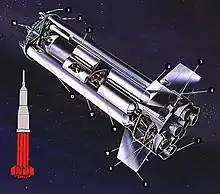S-I
The S-I was the first stage of the Saturn I rocket used by NASA for the Apollo program.[1]
 S-I diagram | |
| Manufacturer | Chrysler |
|---|---|
| Country of origin | United States |
| Used on | Saturn I |
| General characteristics | |
| Height | 24.5 m (80.3 feet) |
| Diameter | 6.5 m (21.4 feet) |
| Gross mass | 432,681 kg (953,898 lb) |
| Propellant mass | 397,414 kg (854,101 lb) |
| Empty mass | 45,267 kg (99,796 lb) |
| Associated stages | |
| Family | Saturn |
| Launch history | |
| Status | Retired |
| Total launches | 10 |
| Successes stage only) | 10 |
| First flight | October 27, 1961 |
| Last flight | July 30, 1965 |
| S-I engine details | |
| Powered by | 8 H-1 engines |
| Maximum thrust | (vac) 7,582.1 KN (1,704,524 lbf) |
| Specific impulse | 289 sec |
| Propellant | RP-1 / LOX |
Design
The S-I stage was powered by eight H-1 rocket engines[2] burning RP-1 fuel with liquid oxygen (LOX) as oxidizer. The design of the S-I was based on Jupiter and Redstone tanks to leverage existing chains. A central Jupiter tank[3] was surrounded by a cluster of eight Redstone tanks. Four of these Redstone tanks contained LOX and four contained RP-1. The outer tanks were painted to alter thermal conditions inside the tanks and to provide a "roll pattern" used to estimate radial motion during flight.[4] The engines were arranged in two clusters, a group of four fixed central engines and a group of four outer gimbaled engines. The gimbals allowed the stage to be controlled with thrust vectoring. On launches after SA-5, eight fins were added to enhance control during atmospheric flight.
History
The S-I stage was developed by Chrysler and consisted of 9 tanks that were previously used on existing rockets. The central tank was a Jupiter tank that held liquid oxygen. This Jupiter tank was sounded by eight Redstone tanks, four for liquid oxygen and four for RP-1. The first four launches had no fins on the S-I, but the remaining six added them to improve stability during atmospheric flight.[5] The initial launch of the Saturn I consisted of an active S-I, an inactive S-IV and inactive S-V stage. Tensions were high as a launch vehicle of this size had never flown before. The S-I was partially loaded with propellant to lessen the destruction if an anomaly occurred near or on the pad.[6] In the end, the launch was successful and the subsequent SA-5 launch was identified by John F. Kennedy as the launch that put the U.S. above the USSR in terms of lift capability.[7]
Flight history
| Mission serial number | Launch date
(UTC) |
Launch notes |
|---|---|---|
| SA-1 | October 27, 1961
15:06:04 |
First test flight. Block I. Suborbital. Range: 398 km. Apogee: 136.5 km. Apogee Mass: 115,700 lb (52,500 kg). Dummy S-IV and S-V stages. |
| SA-2 | April 25, 1962
14:00:34 |
Second test flight. Block I. Suborbital. 86,000 kg water released at apogee of 145 km as part of Project Highwater. Dummy S-IV and S-V stages. |
| SA-3 | November 16, 1962
17:45:02 |
Third test flight. Block I. Suborbital. 86,000 kg water released at apogee of 167 km. Dummy S-IV and S-V stages. Second and last Project Highwater flight. |
| SA-4 | March 28, 1963
20:11:55 |
Fourth test flight. Block I. Suborbital. Dummy S-IV second stage and S-V third stage. Apogee: 129 km. Range: 400 km. |
| SA-5 | January 29, 1964
16:25:01 |
First live S-IV second stage. First Block II. First to orbit: 760 x 264 km. Mass: 38,700 lb (17,550 kg). Decayed 30 April 1966. |
| SA-6 | May 28, 1964
17:07:00 |
First Apollo boilerplate CSM launch. Block II. Orbit: 204 x 179 km. Mass: 38,900 lb (17,650 kg). Apollo BP-13 decayed 1 June 1964. |
| SA-7 | September 18, 1964
16:22:43 |
Second Apollo boilerplate CSM launch. Block II. Orbit: 203 x 178 km. Mass: 36,800 lb (16,700 kg). Apollo BP-15 decayed 22 September 1964. |
| SA-9 | February 16, 1965
14:37:03 |
Third Apollo boilerplate CSM. First Pegasus micrometeoroid satellite. Orbit: 523 x 430 km. Mass: 3,200 lb (1,450 kg). Pegasus 1 decayed 17 September 1978. Apollo BP-26 decayed 10 July 1985. |
| SA-8 | May 25, 1965
07:35:01 |
Fourth Apollo boilerplate CSM. Only night launch. Second Pegasus micrometeoroid satellite. Orbit: 594 x 467 km. Mass: 3,200 lb (1,450 kg). Pegasus 2 decayed 3 November 1979. Apollo BP-16 decayed 8 July 1989. |
| SA-10 | July 30, 1965
13:00:00 |
Third Pegasus micrometeoroid satellite. Orbit: 567 x 535 km. Mass: 3,200 lb (1,450 kg). Pegasus 3 decayed 4 August 1969. Apollo BP-9A decayed 22 November 1975. |
References
- "S-I stage". Archived from the original on December 28, 2016.
- "Saturn family".
- "Saturn Illustrated Chronology – Part 1".
- "Saturn Illustrated Chronology - Part 2".
- "Saturn I & IB Rockets".
- "Saturn I". Archived from the original on August 20, 2016.
- "President John F. Kennedy's Remarks at Brooks Air Force Base, San Antonio, TX – November 21, 1963".